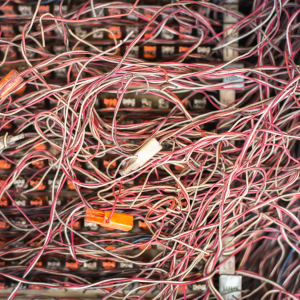In today’s digital age, businesses rely heavily on efficient and reliable network infrastructure. However, traditional cabling solutions can have a surprising environmental impact. That’s where the more eco-friendly cabling option, structured cabling, comes in.
In this blog, we will explore the environmental drawbacks of traditional cabling and share how structured cabling offers a more sustainable and cost-effective alternative for businesses.
The Hidden Costs of Clutter
While seemingly convenient, traditional cabling setups have hidden environmental (and financial) costs. The tangled mess of wires often uses more material than necessary, leading to increased resource extraction (think: copper) and the pollution associated with manufacturing extra cables. Additionally, poor airflow caused by these tangled cables forces cooling systems to work much harder, raising energy consumption, exhausting machines, and requiring early replacements. Finally, the limitations of traditional cabling necessitate frequent upgrades as technology evolves, generating e-waste and further environmental harm.

Fortunately, structured cabling tackles these environmental concerns head-on. Unlike traditional setups, structured cabling offers a streamlined and sustainable approach to network infrastructure.
Structured Cabling: An Eco-Friendly Network Solution
Imagine your network as a roadway. Traditional cabling can be like a maze of backroads and shortcuts, unproductive and prone to jams when traffic picks up. Structured cabling, on the other hand, is like a well-planned highway system – organized, efficient, and built to handle future growth.
Structured cabling is a standardized approach to designing and installing a network infrastructure. It uses high-quality cables labeled and organized according to specific layouts. These cables are routed through pathways and channels, ensuring optimal airflow and minimizing clutter.
Why is Structured Cabling More Sustainable?
By choosing structured cabling, you’re not just investing in a more efficient network but contributing to a greener future. Here’s how:
- Reduced Energy Consumption: A report by Uptime Institute suggests that data centers can achieve 10-30% reductions in energy consumption by implementing structured cabling solutions. We can easily attribute this reduction to improved airflow, reduced reliance on additional cooling units, and decreased heat generation from equipment due to better organization. Lowering your business’s energy use significantly decreases your carbon footprint and helps your business’s bottom line.
- Minimized Waste: As mentioned above, traditional cabling layouts often use more cable than necessary due to messy layouts and needing to account for tangles and future changes. When you hire the right structured cable company for your installation, you can bet on your cabling system to last between 10 and 20 years, with some sources suggesting it could even last longer depending on factors like maintenance and installation quality. With structured cabling, you’ll generate less e-waste from discarded cables and outdated equipment.

- Green Cable Trend: Some structured cabling manufacturers are incorporating environmentally friendly practices by using recyclable materials in certain components. While not all elements are currently recyclable, this trend towards sustainable materials signifies a further commitment to reducing the environmental impact of structured cabling systems throughout their lifecycle. Nowadays, it’s much easier to find parts like plastic cable jackets, trays, and pathway systems made from recycled materials.
- Scalability for Sustainability: Structured cabling utilizes standardized components and layouts, allowing for easy adaptation to accommodate new technologies and increased network demands. Its modular design eliminates the need for wasteful equipment swaps every time your business grows or technology evolves. Instead of ripping out and replacing old cabling infrastructure and installing completely new systems, you can add additional components or rearrange existing ones within the structured framework.
To explore some of the more environmentally friendly products (including packaging) and manufacturing processes we use in the structured cabling industry, visit the Communications Cable & Connectivity Association (CCCA)’s website: https://cccassoc.org/environment/
The Road to a Greener Future Starts with Your Network

By transitioning from traditional cabling to a structured cabling system, your business can achieve significant environmental benefits alongside improved network efficiency and cost savings. Reduced energy consumption, minimized waste generation, and the potential for future expansion using existing infrastructure all contribute to a more sustainable future.
Ready to make your network more sustainable? Contact us today for a free quote. We’ll help you design and implement a structured cabling solution that meets your business’s unique needs and environmental goals.
Together, we can build a more sustainable and connected tomorrow.

